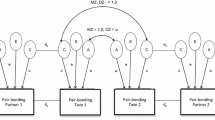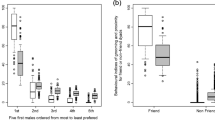Abstract
Pair bonding is a term used in biology to indicate a strong interindividual relationship within breeding pairs most often consisting of a male and a female. The term is closely related to social monogamy, a mating system based on long-lasting relationships between sexual partners. Social monogamy differs from sexual monogamy in that it does not imply sexual exclusivity.
Similar content being viewed by others
References
French, J. A., Taylor, J. H., Mustoe, A. C., & Cavanaugh, J. (2016). Neuropeptide diversity and the regulation of social behavior in New World primates. Frontiers in Neuroendocrinology. doi:10.1016/j.yfrne.2016.03.004.
Johnson, Z. V., Walum, H., Jamal, Y. A., Xiao, Y., Keebaugh, A. C., Inoue, K., & Young, L. J. (2016). Central oxytocin receptors mediate mating-induced partner preferences and enhance correlated activation across forebrain nuclei in male prairie voles. Hormones and Behavior, 79, 8–17. doi:10.1016/j.yhbeh.2015.11.011.
Johnson, Z. V., & Young, L. J. (2015). Neurobiological mechanisms of social attachment and pair bonding. Current Opinion in Behavioral Sciences, 3, 38–44. doi:10.1016/j.cobeha.2015.01.009.
King, L. B., Walum, H., Inoue, K., Eyrich, N. W., & Young, L. J. (2015). Variation in the oxytocin receptor gene predicts brain region-specific expression and social attachment. Biological Psychiatry. doi:10.1016/j.biopsych.2015.12.008.
Klatt, J. D., & Goodson, J. L. (2013). Oxytocin-like receptors mediate pair bonding in a socially monogamous songbird. Proceedings of the Biological Sciences, 280(1750), 20122396. doi:10.1098/rspb.2012.2396.
Lukas, D., & Clutton-Brock, T. H. (2013). The evolution of social monogamy in mammals. Science, 341(6145), 526–530. doi:10.1126/science.1238677.
Okhovat, M., Berrio, A., Wallace, G., Ophir, A. G., & Phelps, S. M. (2015). Sexual fidelity trade-offs promote regulatory variation in the prairie vole brain. Science, 350(6266), 1371–1374. doi:10.1126/science.aac5791.
Phelps, S. M. (2010). From endophenotypes to evolution: social attachment, sexual fidelity and the avpr1a locus. Current Opinion in Neurobiology, 20(6), 795–802. doi:10.1016/j.conb.2010.09.002.
Ross, H. E., & Young, L. J. (2009). Oxytocin and the neural mechanisms regulating social cognition and affiliative behavior. Frontiers in Neuroendocrinology, 30(4), 534–547. doi:10.1016/j.yfrne.2009.05.004.
Young, L. J., & Wang, Z. (2004). The neurobiology of pair bonding. Nature Neuroscience, 7(10), 1048–1054. doi:10.1038/nn1327.
Author information
Authors and Affiliations
Corresponding author
Editor information
Editors and Affiliations
Rights and permissions
Copyright information
© 2016 Springer International Publishing AG
About this entry
Cite this entry
Walum, H., Young, L.J. (2016). Exclusivity and Pair-Bonding Among Non-humans. In: Weekes-Shackelford, V., Shackelford, T., Weekes-Shackelford, V. (eds) Encyclopedia of Evolutionary Psychological Science. Springer, Cham. https://doi.org/10.1007/978-3-319-16999-6_3404-1
Download citation
DOI: https://doi.org/10.1007/978-3-319-16999-6_3404-1
Received:
Accepted:
Published:
Publisher Name: Springer, Cham
Online ISBN: 978-3-319-16999-6
eBook Packages: Springer Reference Behavioral Science and PsychologyReference Module Humanities and Social SciencesReference Module Business, Economics and Social Sciences




